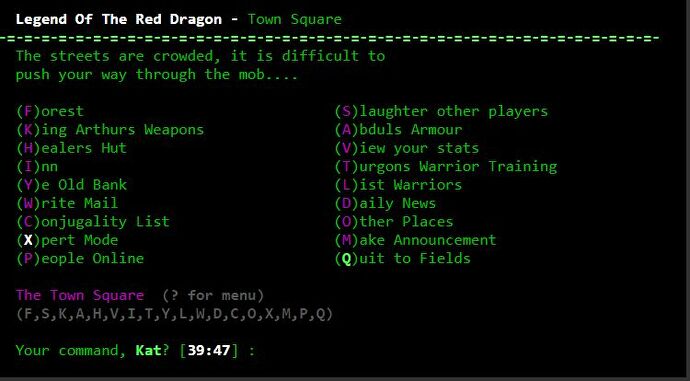Before the internet became a thing people who wanted to send email or download games would connect, via their telephone, to a BBS. They could browse the BBS via a menu, send mail to others, download images or play online games. Legend of the Red Dragon was one of those games and it was a lot of fun.
What was a BBS?
A BBS is Bulletin Board System. They were used by computer enthusiasts to converse with like minded people or download files, such as games, images or read articles and email. Their computer had a MODEM (Modulator / Demodulator ) attached through which they dialed the telephone number, making a connection before logging in. A crude menu was presented offering functions such as ‘Read Mail’, ‘Play Games’, ‘Download Software’, etc. They could also send email around the world in much the same way as we can now, albeit slower. If I wanted to send email to someone in England from Australia the journey could potentially take a day or two. From a CPU power point of view; these machines were 386 40 Mhz or perhaps even a 486. Super brilliant in their day not to mention expensive too.
Online games were very popular
There were various games available for users to play, many of which were multiplayer games allowing one user to compete with others. Because many BBS’s had a single incoming phone line game play would be slow with one player at a time. After completion they waited a day or two for other players to play their respective rounds; therefore games may last weeks or even months. Some of the larger BBS’s had multiple phone lines in which case game play could progress faster. Telephone lines were expensive and any income from a BBS for the owner (known as a Sysop) would be minimal, and often did not cover costs associated with running a BBS.
When you selected a game from the menu the BBS software created a ‘drop’ file containing information about the user such as username, full name, gender, security level etc. Then it would effectively exit and hand control over to the game, which would read the ‘drop’ and gather the info it needs. Similarly once the game exited it would update the ‘drop’ file and hand control back to the BBS. It was a simple, elegant and effective process.
Legend of the Red Dragon (LORD) was very popular

The game was text based. Navigating within the realm was done by selecting keys representing whatever you wanted to do from the options onscreen. From memory you had a limited number of ‘fights’ per day after which you had to leave and return another day. The daily news gave you a rundown of what had transpired while you were away. It was important to know if you had your ass kicked by another warrior, who would have taken your gold or gems. Gold & gems were the currency used to purchase weapons & armour; the better your weapons the harder you could fight, while tougher armour would reduce injuries.
Walking through the forest often results in your stumbling upon another warrior, at which time you decide between attacking or running away. Choosing attack was your opportunity to beat the hell out of another warrior (perhaps someone you knew in the real world) and take their gold & gems. The more currency you have the better your armour and weapon and the longer your health points lasted.
Building a satisfactory number of gold coins was difficult in the beginning because at the end of each game you were forced to sleep in a field, thereby increasing the likelihood another warrior would find you and kick the sh*t out of you. Once you had some coins in your pocket you may have been able to afford to stay at the inn, where you would be safe.
The ultimate goal was to increase your levels until you found and killed the Red Dragon.
In Game Modules (IGM)
Seth Robinson created LORD. One of the many clever things he did was allow other programmers, such as myself, to write extensions for the game. Selecting the ‘Other Places’ option would list your available IGM’s, effectively creating endless opportunities limited only by your imagination.
Weapons of War (WoW) – IGM
Writing the ‘Weapons of War’ was a lot of fun. It was written while chasing my future wife too. In fact, with each release I would briefly document our lives together. At the bottom of the documentation was a list of bug fixes over previous versions along with hints about us. For example, below is the bug fix list for version 2.3.
Bug Fixes
A: Solved problem that allowed player to buy a weapon or armour for
59,000,000 and then sell it in LORD for 200,000,000.
B: Now displays the correct node number.
C: Managed to compile the source code without any errors! Cool.
D: Met a stunning woman and fell head over heals.
C: As at 27 July 1995 she has been away for 3 days, I miss her heaps.
D: On 28 July 1995 I met her other half, but he didn't want to meet me.
E: Fixed (I think) problem with gold and safe amounts exceeding
the maximum that LORD will accept.
F: Hmm, censored.
G: My broken rib is feeling much better, except when I sneeze.
H: Players who are dead can nolonger re-enter WoW. The problem
was in LORD 326, not WoW. Seth fixed it in version 350 of LORD.Back in the 90’s programmers spent more time optimising their software. With limited memory available we had to make things small and fast, unlike current programmers who don’t seem to care. Now they write incredibly bloated & slow software without a care in the world. The entire Weapon of War download file was only 78 kilobytes in size. Can you find a smaller program one your PC?
Every routine, function and procedure was written from scratch without having access to easy libraries & dlls which such as those which exist today. There was no GUI or inline error checking. You wouldn’t know if there were errors until you tried to compile. Routines were written and rewritten in an effort to reduce CPU Cycles and how many bytes of memory were used. Ah, the good old days of software development.
Pink Bra and Panties Set
Because my sense of humour is a little off at times I attempted to create an IGM which caused me to chuckle. The weapons & armour you could buy within LORD were pretty mainstream whereas WoW offered some more interesting choices, such as a rubber chicken and a pink bra and pantie set. It made for interesting daily news when reading “Warrior Boris The Beast was killed by Ivan The Terrible with a Rubber Chicken, wearing a Pink Bra & Pantie Set“. Always good for a laugh.
There was also a bank allowing warriors to deposit their coins into the vault before returning to the fields; safe in the knowledge their hard earned cash isn’t going to be stolen – or was it. Other players could attempt to open the vault, so it was always a gamble. The odds against opening the vault were stacked against the potential thieving dirt bag. Cracking the safe was very rare.
Cheats – My biggest programming regret
I have been writing software for 35 years and have few regrets. Having said that, the biggest regret of my life has always been adding cheats into the Weapons Of War. I did it for my friends and told three of them how to use the cheats. I told them to never tell anyone about them. Guess what – somebody blabbed! Word got out around the world and I have regretted it ever since. The cheats included a visit to medieval McDonald’s for a cheeseburger which increased your health. Others gave you more gold or made you almost indestructible. Extremely stupid of me.
Of the hundreds of applications I’ve written, the cheats in WoW are the things I really regret and would remove them if I had a suitable time machine. I did start removing them around version 2.6 but never got a chance to release it.
Initially the Weapons of War IGM got very good reviews around the world for which I was grateful. Once the cheats got out reviewers weren’t as kind and I got messages from Sysops everywhere begging me to remove them.
If you were affected by these cheats, I apologise from the bottom of my heart.
